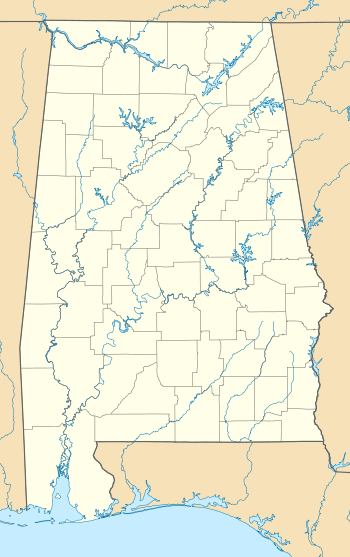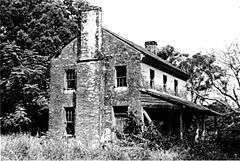McGehee–Stringfellow House
|
McGehee–Stringfellow House | |
|
The house in September 1979 | |
  | |
| Nearest city | Greensboro, Alabama |
|---|---|
| Coordinates | 32°45′7″N 87°40′41″W / 32.75194°N 87.67806°WCoordinates: 32°45′7″N 87°40′41″W / 32.75194°N 87.67806°W |
| Built | 1824 |
| Architectural style | Federal |
| NRHP Reference # | 80000686[1] |
| Added to NRHP | September 17, 1980 |
The McGehee–Stringfellow House, also known as Oak Grove, was a historic plantation house near Greensboro, Alabama, United States. It was added to the National Register of Historic Places on September 17, 1980, due to its architectural significance.[1]
History
The house was built by Abraham and Harriet Hill McGehee. Abraham McGehee was born in Oglethorpe County, Georgia in 1791, Harriet was born in 1798. They married in 1817. By 1824 they had relocated to Alabama and were building the house. Construction on the house stopped after Harriet's death on February 25, 1826. She was the first burial in the family cemetery on the property. McGehee sold the house and the 800-acre (3.2 km2) plantation property to Enoch Stringfellow and then migrated to Mississippi. Enoch Stringfellow died in 1839 and the house was inherited by his son, McDonald. McDonald Stringfellow died in 1875, but the house remained in the Stringfellow family until the late 1970s. However, the house had begun to deteriorate in the 1940s due to deferred maintenance. The house and surrounding property were sold in the 1970s to MacMillan Bloedel, a forestry company. The company attempted to move the house from the property in the 1980s, but the brick structure collapsed while still on its original site.[2] The house site remains on the National Register of Historic Places.[1]
Architecture
The McGehee–Stringfellow House was built in the Federal-style.[1] It was a two-story structure with two rooms and a central hall on each floor. The entire house was built from brick that was handmade on the plantation by McGehee's slaves. It featured side gables and a symmetrical three-bay facade. Both sides of the house had large external chimneys centered in the wall, with windows to either side on both floors. The original woodwork in the house was joined using the older technique of wooden pegs, rather than nails. McGehee had planned a two-story brick ell for the rear of the house, but it was not built due to Harriet's death. Instead, Enoch Stringfellow added a frame addition to the rear of the house, as well as a detached one-story log kitchen. The log structure was replaced by McDonald Stringfellow with a frame building housing the kitchen and dining room. It was connected to the house by a covered breezeway.[2]
References
- 1 2 3 4 National Park Service (2008-04-15). "National Register Information System". National Register of Historic Places. National Park Service.
- 1 2 Hale County Heritage Book Committee (2001). The heritage of Hale County, Alabama. Clanton, Alabama: Heritage Publishing Consultants. pp. 19–20. ISBN 1-891647-51-2.
